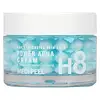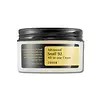What's inside
What's inside
 Key Ingredients
Key Ingredients

 Benefits
Benefits

 Concerns
Concerns

 Ingredients Side-by-side
Ingredients Side-by-side

Water
Skin ConditioningDipropylene Glycol
HumectantGlycerin
HumectantButylene Glycol
Humectant1,2-Hexanediol
Skin ConditioningIsopropyl Isostearate
EmollientNiacinamide
SmoothingSodium Hyaluronate
HumectantHydroxypropyltrimonium Hyaluronate
Caprylic/Capric Triglyceride
MaskingHydrolyzed Hyaluronic Acid
HumectantSodium Acetylated Hyaluronate
HumectantHyaluronic Acid
HumectantAcetyl Hexapeptide-8
HumectantSodium Hyaluronate Crosspolymer
HumectantHydrolyzed Sodium Hyaluronate
Skin ConditioningAstaxanthin
Skin ConditioningPotassium Hyaluronate
Skin ConditioningLavandula Angustifolia Flower Extract
CleansingSalvia Sclarea Extract
AntiseborrhoeicHyacinthus Orientalis Extract
Skin ConditioningChamomilla Recutita Flower Extract
MaskingBorago Officinalis Extract
EmollientCentaurea Cyanus Flower Extract
AstringentCarbomer
Emulsion StabilisingArginine
MaskingBeeswax
Emulsion StabilisingButyrospermum Parkii Butter
Skin ConditioningStearyl Alcohol
EmollientHydrogenated Polyisobutene
EmollientDimethicone
EmollientSorbitan Stearate
EmulsifyingPanthenol
Skin ConditioningPolysorbate 60
EmulsifyingPEG-40 Hydrogenated Castor Oil
EmulsifyingPalmitic Acid
EmollientC14-22 Alcohols
Emulsion StabilisingAmmonium Acryloyldimethyltaurate/Vp Copolymer
Hydrogenated Lecithin
EmulsifyingAdenosine
Skin ConditioningPolyacrylate-13
C12-20 Alkyl Glucoside
EmulsifyingTocopheryl Acetate
AntioxidantDisodium EDTA
Polyisobutene
Propanediol
SolventPolyglyceryl-10 Distearate
EmulsifyingEthylhexylglycerin
Skin ConditioningPolysorbate 20
EmulsifyingSorbitan Isostearate
EmulsifyingGlucose
HumectantCI 42090
Cosmetic ColorantParfum
MaskingHexyl Cinnamal
PerfumingAlpha-Isomethyl Ionone
PerfumingHydroxycitronellal
PerfumingCitronellol
PerfumingLimonene
PerfumingGeraniol
PerfumingLinalool
PerfumingWater, Dipropylene Glycol, Glycerin, Butylene Glycol, 1,2-Hexanediol, Isopropyl Isostearate, Niacinamide, Sodium Hyaluronate, Hydroxypropyltrimonium Hyaluronate, Caprylic/Capric Triglyceride, Hydrolyzed Hyaluronic Acid, Sodium Acetylated Hyaluronate, Hyaluronic Acid, Acetyl Hexapeptide-8, Sodium Hyaluronate Crosspolymer, Hydrolyzed Sodium Hyaluronate, Astaxanthin, Potassium Hyaluronate, Lavandula Angustifolia Flower Extract, Salvia Sclarea Extract, Hyacinthus Orientalis Extract, Chamomilla Recutita Flower Extract, Borago Officinalis Extract, Centaurea Cyanus Flower Extract, Carbomer, Arginine, Beeswax, Butyrospermum Parkii Butter, Stearyl Alcohol, Hydrogenated Polyisobutene, Dimethicone, Sorbitan Stearate, Panthenol, Polysorbate 60, PEG-40 Hydrogenated Castor Oil, Palmitic Acid, C14-22 Alcohols, Ammonium Acryloyldimethyltaurate/Vp Copolymer, Hydrogenated Lecithin, Adenosine, Polyacrylate-13, C12-20 Alkyl Glucoside, Tocopheryl Acetate, Disodium EDTA, Polyisobutene, Propanediol, Polyglyceryl-10 Distearate, Ethylhexylglycerin, Polysorbate 20, Sorbitan Isostearate, Glucose, CI 42090, Parfum, Hexyl Cinnamal, Alpha-Isomethyl Ionone, Hydroxycitronellal, Citronellol, Limonene, Geraniol, Linalool
Snail Secretion Filtrate
Skin ConditioningBetaine
HumectantCaprylic/Capric Triglyceride
MaskingButylene Glycol
HumectantCetearyl Olivate
Sorbitan Olivate
EmulsifyingCetearyl Alcohol
EmollientCarbomer
Emulsion StabilisingEthyl Hexanediol
SolventPhenoxyethanol
PreservativeArginine
MaskingDimethicone
EmollientSodium Polyacrylate
AbsorbentSodium Hyaluronate
HumectantAllantoin
Skin ConditioningPalmitic Acid
EmollientPanthenol
Skin ConditioningXanthan Gum
EmulsifyingStearic Acid
CleansingAdenosine
Skin ConditioningWater
Skin ConditioningMyristic Acid
CleansingSnail Secretion Filtrate, Betaine, Caprylic/Capric Triglyceride, Butylene Glycol, Cetearyl Olivate, Sorbitan Olivate, Cetearyl Alcohol, Carbomer, Ethyl Hexanediol, Phenoxyethanol, Arginine, Dimethicone, Sodium Polyacrylate, Sodium Hyaluronate, Allantoin, Palmitic Acid, Panthenol, Xanthan Gum, Stearic Acid, Adenosine, Water, Myristic Acid
 Reviews
Reviews

Ingredients Explained
These ingredients are found in both products.
Ingredients higher up in an ingredient list are typically present in a larger amount.
Adenosine is in every living organism. It is one of four components in nucleic acids that helps store our DNA.
Adenosine has many benefits when used. These benefits include hydrating the skin, smoothing skin, and reducing wrinkles. Once applied, adenosine increases collagen production. It also helps with improving firmness and tissue repair.
Studies have found adenosine may also help with wound healing.
In skincare products, Adenosine is usually derived from yeast.
Learn more about AdenosineArginine is an amino acid that is important for human development. Your body uses is it to produce hair keratin and skin collagen.
As a cosmetic ingredient, Arginine has antioxidant properties and can also help repair damaged skin. This ingredient is derived either synthetically or from animals.
Arginine isn't fungal acne safe when used in the presence of other lipids (fats, fatty acids, oils, esters, etc). Oils and fats occur naturally within the skin, so take caution when using Arginine if you're prone to fungal acne.
Learn more about ArginineButylene Glycol (or BG) is used within cosmetic products for a few different reasons:
Overall, Butylene Glycol is a safe and well-rounded ingredient that works well with other ingredients.
Though this ingredient works well with most skin types, some people with sensitive skin may experience a reaction such as allergic rashes, closed comedones, or itchiness.
Learn more about Butylene GlycolThis ingredient is an emollient, solvent, and texture enhancer. It is considered a skin-softener by helping the skin prevent moisture loss.
It helps thicken a product's formula and makes it easier to spread by dissolving clumping compounds.
Caprylic Triglyceride is made by combining glycerin with coconut oil, forming a clear liquid.
While there is an assumption Caprylic Triglyceride can clog pores due to it being derived from coconut oil, there is no research supporting this.
Learn more about Caprylic/Capric TriglycerideCarbomer is a polymer of acrylic acid. Its main role is to create a gel consistency.
A high amount of carbomer can cause pilling or balling up of products. Don't worry, most products contain 1% or less of carbomer.
Dimethicone is a type of synthetic silicone created from natural materials such as quartz.
What it does:
Dimethicone comes in different viscosities:
Depending on the viscosity, dimethicone has different properties.
Ingredients lists don't always show which type is used, so we recommend reaching out to the brand if you have questions about the viscosity.
This ingredient is unlikely to cause irritation because it does not get absorbed into skin. However, people with silicone allergies should be careful about using this ingredient.
Note: Dimethicone may contribute to pilling. This is because it is not oil or water soluble, so pilling may occur when layered with products. When mixed with heavy oils in a formula, the outcome is also quite greasy.
Learn more about DimethiconePalmitic Acid is a fatty acid naturally found in our skin and in many plant and animal sources. In cosmetics, it is usually derived from palm oil. It serves many purposes in skincare, acting as a cleanser, emollient, and emulsifier.
As an emollient, palmitic acid helps soften and smooth the skin by preventing water loss. In cleansers, it helps remove oil and dirt while creating foam.
Its emulsifying properties help stabilize products by keeping water and oil-based ingredients from separating.
This may not be suitable for fungal acne-prone skin, as fatty acids like this can sometimes trigger breakouts in sensitive individuals.
Learn more about Palmitic AcidPanthenol is a common ingredient that helps hydrate and soothe the skin. It is found naturally in our skin and hair.
There are two forms of panthenol: D and L.
D-panthenol is also known as dexpanthenol. Most cosmetics use dexpanthenol or a mixture of D and L-panthenol.
Panthenol is famous due to its ability to go deeper into the skin's layers. Using this ingredient has numerous pros (and no cons):
Like hyaluronic acid, panthenol is a humectant. Humectants are able to bind and hold large amounts of water to keep skin hydrated.
This ingredient works well for wound healing. It works by increasing tissue in the wound and helps close open wounds.
Once oxidized, panthenol converts to pantothenic acid. Panthothenic acid is found in all living cells.
This ingredient is also referred to as pro-vitamin B5.
Learn more about PanthenolSodium Hyaluronate is hyaluronic acid's salt form. It is commonly derived from the sodium salt of hyaluronic acid.
Like hyaluronic acid, it is great at holding water and acts as a humectant. This makes it a great skin hydrating ingredient.
Sodium Hyaluronate is naturally occurring in our bodies and is mostly found in eye fluid and joints.
These are some other common types of Hyaluronic Acid:
Learn more about Sodium HyaluronateWater. It's the most common cosmetic ingredient of all. You'll usually see it at the top of ingredient lists, meaning that it makes up the largest part of the product.
So why is it so popular? Water most often acts as a solvent - this means that it helps dissolve other ingredients into the formulation.
You'll also recognize water as that liquid we all need to stay alive. If you see this, drink a glass of water. Stay hydrated!
Learn more about Water